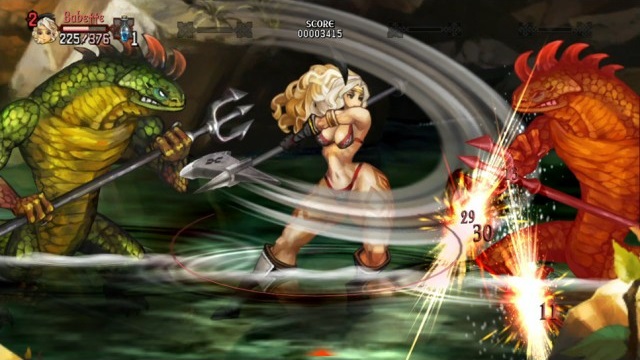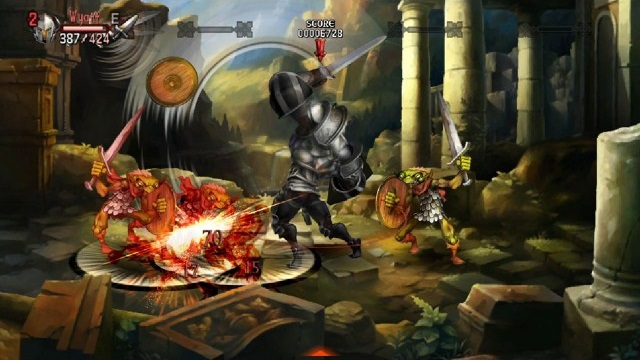Screw the snake. It's always the year of the dragon.
By and large, I should start this review by commenting on the breast size of the Sorceress, but there's plenty of time to milk this subject later.
For a point of comparison, Dragon's Crown is a modern update on the classic fantasy 2.5D beat-'em-up genre represented by the likes of Dungeons & Dragons: Chronicles of Mystara, the HD remake of which left fellow GameRevolutionary Daniel Bischoff unimpressed. The quarter-sucking difficulty that made the title so addictive in the arcade is unfortunately inappropriate for the video game consoles of today. Luckily, Dragon's Crown escapes most of that title's problems with ease, breathing life to a stagnant genre and giving the PS3 and the Vita one of the finest exclusives this year.
The painterly, exquisite art style of Dragon's Crown is unmistakable. Similar to his work in Odin Sphere and the highly under-rated Muramasa: The Demon's Blade, art director George Kamitani spared no expense in the rippling, vivid details of the enemies, the characters, and the environments. Nearly every frame could easily be chosen to be hung in the annual Into The Pixel art gallery at the Electronic Games Expo. Say what you will about the scantily clad Amazon and the Sorceress's booby physics—everything is downright gorgeous.
Dragon's Crown is, indeed, a labor of love, costing developer VanillaWare over 100 million yen to produce, though Kamitani-san was inspired to design it more than a decade ago when he worked on Princess Crown for Sega Saturn in 1997. This dream was almost dashed when the initial publisher Ignition pulled out last year, but Atlus swooped in to save the day, as if it doesn't already have enough bullet points in the "win" column.
As you might have surmised from the screenshots, Dragon's Crown challenges players in traditional form to complete a series of fairly linear stages, strewn with loot, enemies, and mystery, and slay the level-end boss with well-timed skill and precision. The moveset of the six-member roster is incredibly wide no matter whom you choose, whether it's the iron-clad Fighter (who has obviously been ignoring his leg workouts), the axe-wielding Amazon, the pugilistic Dwarf, the nimble Elf, the teleporting Wizard, or the sensuous Sorceress. Every player character can swiftly evade, dish out serious damage with either air juggles or powerful spells, and consume various items on the fly. The synergy between classes is as plain to see just by forming a four-party combination of front-line warriors defending long-range mages and archers.
Here, getting a higher score isn't just for kicks or a reference to high scores, but lead to greater experience bonuses and extra lives for all party members. Keeping an eye out for every coin and tapping the screen (or using the cursor on the PS3 version) for twinkling spots ensure that the score remains high. The extended life bonus in particular is a must for the end-game levels.

In between each stage, players can explore the town hub, meant to be simple and straightforward in order for players to get back into the action as quickly as possible. Items, treasure-ranked from letters 'E' to 'S' and gathered by the party's traveling, chest-opening thief, can be sold, appraised, and equipped. Item durability is unnecessary, though, and could have been eliminated altogether. None of the item shops sell weapons or equipment, encouraging players to replay levels in the hopes of collecting more useful treasure. The Adventurer's Guild allows players to spend skill points, from leveling up and completing side quests, to acquire and upgrade class-specific abilities or more general stats like vitality, item slots, and evasive maneuvers.
Entering the Castle typically advances the storyline, which revolves around political intrigue and the acquisition of the fabled, titular Dragon's Crown rumored to have the ability to control the ultimate power of the dragons. Unfortunately, the plot suffers from character art portraits that, although equally gorgeous, have only one idle, emotionless animation and have no voice-work whatsoever. The narration attempts to compensate by telling players how everyone is supposed to react, but therein lies the problem: Instead of showing, it tells far too much. It would have been far better to have the NPCs speak on their own behalf.
The most intriguing part of town is the Cathedral, not particularly for its minor boosts for praying, but for the priest's ability to resurrect AI party members from the grave. Any bones players collect along their travels can, for an extremely low price, be brought back to life, in a memorable cut-scene that I sometimes don't skip just to view it again. However, AI partners aren't perfect, as they will run into traps and typically face death more often than human players. But they're better than nothing.
That said, the most serious chink in the game's armor is the locked online multiplayer, which severely hampers the online mode right out of the box. Given the four-player aspect of the title, most consumers will likely make the assumption that they can jump into a session with friends. Though it's possible to start a local multiplayer session fine enough in the PS3 version, the console doesn't have the ability to sign in with multiple accounts, so any progress a co-op buddy might make is nullified. While it only takes about eight hours to complete the nine stages necessary to unlock network play, that may be long enough to deter friends from caring. There's also no indication or pop-up revealing that network play is locked, which mitigates the whole incentive (but now you know…).

Hopefully, players will follow through with at least the first nine stages, because online multiplayer is fantastic and, combined with rune magic hidden in the environment, makes it easier to defeat the more difficult and timed boss fights that appear in the B-path of every stage. From there, completing the main game unlocks harder difficulties which raise the level cap further, effectively extending and reusing the game's core content.
I suppose it behooves me not to ignore the objectification of women. On one hand, it fits the hyper-exaggerated art style, with the male characters also having ridiculously tiny heads to match their ridiculously jacked upper body. On the other hand, it's difficult to deny that it's a distraction hovering around "nose-bleed otaku" territory. I mean, the Sorceress must lean back while running because her endowment is four times the width of her shoulder. (I hear that the real reason she's a sorceress is so she can cast spells that relieve back pain.) But lest I go into an editorialized, multicultural gender study comparing American and Japanese views on the male gaze, let's just say that if this portrayal of women offends you, this game isn't right for you. It's only T-rated, though, so it shouldn't give most players any trouble.
Despite the shenanigans with online multiplayer and the sexualization of women, Dragon's Crown evolves the beat-'em-up genre to the next evolutionary step in overall gameplay and art design. Hands-down, there's no better-looking title on the Vita, a feat any future title on the handheld will have trouble dethroning. Some would even extend that argument to the PS3, and I wouldn't oppose it. Vita owners and old-school fans of beat'-em-up classics owe it to themselves to top their collection off with Dragon's Crown.
-
Modern throwback to classic beat-'em-ups
-
Good variety of classes and movesets
-
Most visually stunning game on Vita by a long way
-
Solid replay value
-
Boobie physics
-
Locked online multiplayer
-
Narration tells far more than it shows







